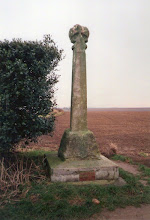After reading Wavell's rather dry "
The Palestine Campaigns" (pardon the pun), I needed to get back to some history told 'against the grain' - a personal narrative of this theatre of war.
I'm now 'enjoying'
Ion Idriess' raw and gritty account of his time with the 5th Light Horse, AIF, in Gallipoli, Sinai and Palestine. A very worthwhile read to get a sense of the horrors endured by the common soldier in this theatre of war.
Having been wounded twice on the Gallipoli peninsular, Idriess find himself convalescing in Egypt. As Gallipoli had been evacuated by this time (March 1916) the 5th finds itself stationed near the old battlefield of Tel-el-Kebir (1882):
Close by is the old battlefield of Tel-el-Kebir. Remnants of buttons, bullets, bayonets and cartridge cases are littered there while yellowed skulls show where the Khamseens have blown the sand away. The scurrying winds have uncovered old bodies in an uncanny state of preservation, surely due to some chemical preservative in the sands. Several boys looked mustily young and sleeping. It was a shock to see them, so still and quiet and old. They gave me an uneasy impression that from some aloof world they were accusing me-and really I never knew they once existed. Our boys buried them deep.
A few days later, while drilling in the sand-swept desert, an officer remarked,
'A man will never need a grave dug if he is shot in this desert."
Ion Idriess,
The Desert Column: Leaves from the Diary of an Australian Trooper in Gallipoli, Sinai and Palestine, Angus and Robertson Ltd, 1934, Sydney, pp. 69-71.
Anyway, with all this wonderful inspiration, I've managed to get my first British infantry brigade together for
If the Lord Spares Us. It's nominally a brigade of the 42nd (East Lancashire) Territorial Division. Here's a few of my typically fuzzy (Sorry! Must buy a decent camera) pics:
The armoured car is from Irregular Miniatures (Improvised Armoured Car IRR-NC099) with a lewis gun from a Peter Pig 'Home Guard' (WW2) figure and the head and torso of an Eureka figure.
I cut the weapon and lower arms from the Lewis gunner, and gut away the same portion of the Eureka figure. Then I cut the legs off the Eureka guy and glued the torso with Lewis gun to the legs of the Irregular gunner. The figure seated in the back of the armoured car was cut out (drilled, actually).
Here's the result. The paint job leaves a lot to be desired - I hope to add some detail and better AFV-style weathering when I learn how to do it!
Ottoman infantry next! Thanks for dropping by.







































